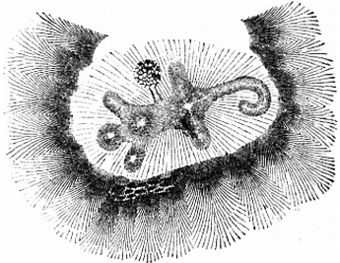Alligator Effigy Mound facts for kids
Quick facts for kids |
|
|
Alligator Effigy Mound
|
|
 |
|
| Nearest city | Granville, Ohio |
|---|---|
| NRHP reference No. | 71000643 |
| Added to NRHP | November 5, 1971 |
The Alligator Effigy Mound is a special type of effigy mound located in Granville, Ohio, United States. An effigy mound is a large shape made from earth, often looking like an animal. People believe this mound was built a long time ago, between the years 800 and 1200 AD. It was likely created by people from the Fort Ancient culture. This mound was probably used for important ceremonies, not for burying people.
It sits on private land and is one of only two known effigy mounds left in Ohio. The other famous one is Serpent Mound. Many more effigy mounds were built by ancient indigenous people in places like Illinois, Iowa, and Wisconsin. The Alligator Effigy Mound has been on the National Register of Historic Places since 1971.
Contents
Discovering the Alligator Mound
Early Surveys: Squier and Davis (1848)
In 1848, two researchers named Ephraim George Squier and Edwin Hamilton Davis studied the mound. They worked for the Smithsonian Institution. They wrote about their findings in a book called Ancient Monuments of the Mississippi Valley.
They described the mound as "strange." It sits on a hill about 150 to 200 feet high. Local people called it "the alligator," even though it also looked like a lizard. The head of the earthwork points towards the southwest.
What the Mound Looks Like
The entire mound is about 250 feet long from head to tail. The body is about 40 feet wide. Each leg measures about 36 feet. Squier and Davis noticed that the ends of the paws were a bit wider. This might have shown where the toes spread out.
The head, shoulders, and back of the mound are higher than the rest. The mound's height ranges from four to six feet. In the middle, there was a small mound. Squier and Davis thought this was an altar. Stones covered the altar, and they showed signs of old fires. A wide path, ten feet across, led from the altar to the top of the effigy.
How the Mound Was Built
The researchers found that the mound was made of clay. This clay seemed to have been brought from another area. They also noticed that the land where the mound was built was very rounded. They wondered if people had shaped the land to make it so perfect. From the top of the mound, other ancient earthworks could be seen, especially those in the Newark group.
Squier and Davis believed the site was used for special ceremonies. They thought it was used for important events or offerings.
Later Research: Lepper and Frolking (1999)
In 1999, archaeologists Brad Lepper and Tod A. Frolking studied the mound again. They used a method called radiometry to date a piece of charcoal found at the bottom of the mound. They found that the mound was built about 1,000 years ago, around 950 AD.
Lepper thinks the Alligator Mound might actually represent an underwater panther. This creature is a powerful figure in Native American myths. He believes that early European settlers might have misunderstood what Native Americans told them. The settlers heard about a fierce creature that lived in the water and ate people. They then thought it must be an alligator.




